| Introduction |
The urgent and continuing need for capacity building to develop the next generation of agricultural experts working across the food system is often highlighted as a major priority in high-level policy documents. N2Africa has contributed to capacity development at all levels from smallholder farmers across the value chains and broader agricultural and food system. ...
|
1 |
| Genetic diversity and genetic component associated with high Nitrogen fixation in indigenous rhizobia nodulating soyabean in South Kivu, Eastern Democratic Republic of Congo |
 |
After her MSc within N2Africa Bintu Nabintu Ndusha is enrolled for PhD at University of Nairobi since 2016 and is working under the supervision of Prof. Shellemia Keya and Richard Onwonga of UoN, Dr Leon Nabahungu of IITA and Prof. Gustave Nachigera from her home institute, Université Evangelique en Afrique. ...
Photo: Bintu Ndusha performing a gel electrophoresis to check DNA quality of rhizobia isolates form D.R.Congo in BecA-ILRI molecular laboratory
|
|
3 |
| Assessment of the impact of improved cowpea varieties on women farmers in southern part of Borno State, Nigeria |
I examined the impact of improved cowpea technology on women farmers which was introduced by the Promoting Sustainable Agriculture in Borno State, (PROSAB), project which was implemented from 2004 to 2009 in Southern Part of Borno State, Nigeria. The specific objectives were to identify the changes in income as a result of using improved cowpea varieties by the respondents, analyze the impact of the improved technology on the food security status of the respondents and identify the constraints associated with the use of improved cowpea varieties. ...
|
4 |
| Phylogenetic multilocus sequence analysis of indigenous Rhizobia nodulating cowpea in Nigeria |
|
The promiscuity ability of cowpea enables it to form nitrogen-fixing root nodules with diverse symbiotic bacteria. It is mainly nodulated by slow-growing bacteria which constitute heterogeneous group of rhizobia called “cowpea miscellany” belonging to the genus Bradyrhizobium. ...
Figure: Neighbour-joining phylogenetic tree based on 751 bp concatenated sequence of glnll and recA showing taxonomic relationships of the strains. Strains isolated in the present study are shown in boldface and type strains are indicated by superscript “T”. Bootstrap values (greater than 50%) were calculated for 1000 replications and are shown at the nodes. The scale bar shows the number of nucleotide substitutions per site. Phylogenetic analysis was conducted in MEGA 7 using the neighbour-joining algorithm with the Kimura 2-parameter model plus Gamma Distributed (G).
|
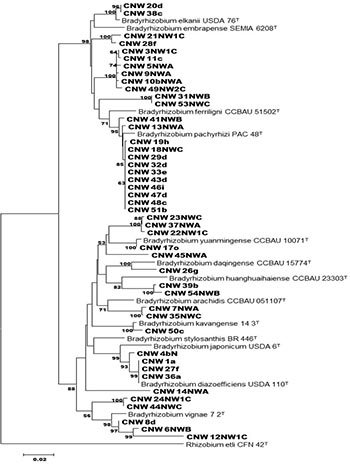
|
|
5 |
| The effects of rhizobial inoculation, phosphorus application and cowpea-cowpea sequential cropping system on some varieties of cowpea on farmers’ fields in Minna, southern Guinea savanna of Nigeria |
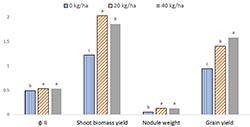 |
The trials conducted in 2016 were repeated in 2017 to determine the effects of phosphorus fertilizer application and rhizobial inoculation on photosynthetic efficiency, nodulation, growth and productivity of three cowpea varieties and secondly to evaluate the performance of some varieties of cowpea in cowpea-cowpea sequential cropping system on three farmers’ fields in Minna, southern Guinea savanna of Nigeria. ...
Figure: Effect of phosphorus application on the performance of cowpea
|
|
6 |
| Phylogeny of rhizobia nodulating common bean (Phaseolus vulgaris L.) in Ethiopia |
|
Common bean (Phaseolus vulgaris L.) is an important food legume and is a main source of protein, hence its nickname ‘poor man’s meat’ (Broughton et al. 2003). It plays a vital role in agriculture by associating with rhizobia and fixing atmospheric N2 through a biological nitrogen fixation (BNF) process. ...
Figure: Only a section of the Neighbour-joining phylogeny of MLSA
|
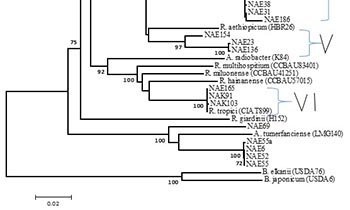 |
|
7 |
| Understanding the influence of barriers on smallholders’ perception and adoption of legume technologies in Ethiopia: A qualitative study |
Studies on adoption of new products, services and technologies by smallholders mainly look into barriers affecting adoption and application of Rogers’ innovation adoption theory (Rogers, 1983). Following the case study research methodology, I studied qualitatively the interaction between adoption barriers and smallholders’ perceptions to develop a detailed understanding on how different barriers have an impact on different adoption perceptions following Rogers’ adoption theory and thereby know smallholders’ decision to adopt. ...
|
8 |
| Perceptions of livestock traders and fatteners on the use of grain legume residues in northern Ghana |
Grain legume residues (GLRs) are among the main feed resources used by livestock producers in northern Ghana, especially during the dry season. GLRs are preferred to cereal residues as livestock feed because of their relatively higher nutrient levels. ...
|
9 |
| Legume-maize rotation or relay? Options for ecological intensification of smallholder farms in the Guinea savanna of northern Ghana |
In this Podcaster, I present a short summary of my third paper recently published in Experimental Agriculture: Kermah, M., Franke, A.C., Ahiabor, B.D.K., Adjei-Nsiah, S., Abaidoo, R.C., & Giller, K.E., (2018). Legume-maize rotation or relay? Options for ecological intensification of smallholder farms in the Guinea savanna of northern Ghana. Experimental Agriculture, 1–19. ...
|
10 |
| Grain legumes within a healthy Ghanaian diet |
|
Recently, we submitted a paper to the Nutrition Journal on the current and potential role of grain legumes on protein (both quantity and quality) and micronutrient adequacy of the diet of rural Ghanaian infants and young children. We collected dietary intake data with repeated quantitative multi-pass 24-hour recall method ...
Photo: Waiting for measurements in Bawku West district
|
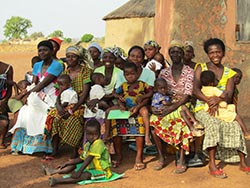 |
|
11 |
| Exploring options to enhance biological nitrogen fixation and yield of soyabean and common bean in smallholder farming systems in Rwanda |
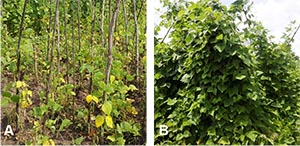 |
After my last PhD updates, a paper was published in the N2Africa Special Issue of Agriculture, Ecosystems and Environment as Rurangwa, E., Vanlauwe, B., Giller, K.E., 2018. Benefits of inoculation, P fertilizer and manure on yields of common bean and soyabean also increase yield of subsequent maize. ...
Figure: Climbing bean grown: (A) with no inputs added, and (B) with inputs added at Muko village
|
|
12 |
| Diversity of soyabean root nodule bacteria recovered from Zimbabwean soils |
Zimbabwe has a long history of soyabean breeding programmes that have developed many improved soyabean varieties with various disease tolerances; and high yields, up to 5t/ha. Soyabean can depend on symbiotic nitrogen fixation (SNF) with root nodule bacteria for their entire nitrogen requirements. ...
|
13 |
| Participatory approaches to diversification and intensification of crop production on smallholder farms in Malawi |
|
This is the title of the PhD thesis that I will be defending on 12th September 2018. It was a challenging year combining the last stretch of the PhD with a busy job, but I am glad to report progress. ...
Photo: Figure 1. Exceptionally good yields were achieved on the demo-sites.
|
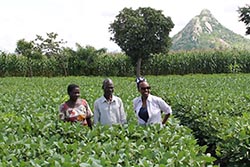 |
|
14 |
| Former PhD students |
Follow up on professional activities of the PhD students that already graduated: Dr Amaral M. Chibeba, Dr George Mwenda and Dr Esther Ronner.
|
15 |
| Former MSc students |
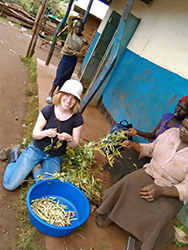 |
This article gives updates on what has happened to fifteen of the students who studied through N2Africa. The seventy reports now on the website are not all from different students as some did both internship and thesis within N2Africa.
Photo: Eva Thuijsman during her MSc research
|
|
16 |
| European nitrogen fixation conference |
|
We (Comfort and Ashenafi) had the opportunity to participate in a 13th European Nitrogen Fixation Conference and a side by side Satellite Workshops from 18-21 August 2018 at München-Bryggeriet in Stockholm, Sweden. We presented our works by a poster (Ashenafi) and pitch speech (Comfort) at the Conference.
Photo: Ashenafi at his poster with Comfort
|
 |
|
17 |
| Reports and other output uploaded on the N2Africa website |
|
18 |
| N2Africa publication |
Variations in seed and post-harvest residue yields and residues quality of common bean (Phaseolus vulgaris L.) as a ruminant feedstuff. 2018. Dejene, M., Dixon, M.B., Duncan, A.J., Wolde-meskel, E., Walsh, K.B., McNeille, D.
|
19 |
| Related newsletters |
|
20 |










